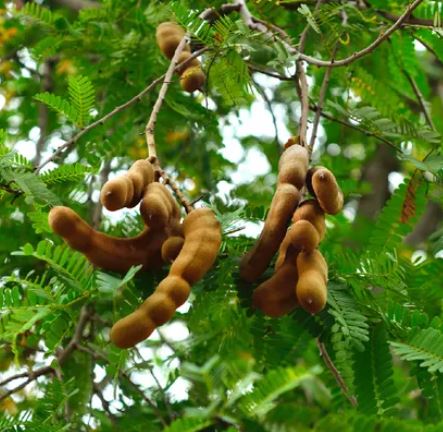Botanical name: Tamarindus Indica | Hindi: इमली | Marathi: चिंच | English: Tamarind
About
The Tamarind tree (Tamarindus indica) is a tropical hardwood tree known for its distinctive, feathery foliage and wide canopy. Native to Africa, it has spread across tropical regions worldwide. The tree produces pod-like fruits containing a sweet and tangy pulp widely used in culinary applications, beverages, and traditional medicine. With a graceful appearance, the Tamarind tree serves as both an ornamental and functional element, providing shade and contributing to the cultural and culinary diversity of its habitat.Interesting Facts

Medicinal Uses: Tamarind has several medicinal properties. Its pulp is rich in antioxidants, and it contains compounds with anti-inflammatory and antimicrobial effects. In traditional medicine, tamarind is used to treat digestive issues, including constipation and diarrhea. It is also believed to have potential benefits for heart health and diabetes management. The high levels of vitamins and minerals in tamarind contribute to its reputation as a health-promoting fruit.

Culture & Tradition: Tamarind holds cultural significance in many regions. In India, for example, tamarind is a common ingredient in various dishes, imparting a unique sweet and tangy flavor. The fruit is also used in traditional Ayurvedic medicine. Tamarind festivals and fairs are organized in some places, celebrating its cultural importance.

Environmental Impact: Tamarind trees play a crucial role in the environment. They are well-adapted to tropical climates and can withstand drought conditions. The trees help prevent soil erosion and contribute to soil fertility. The leaves and organic matter from the tree contribute to nutrient cycling in ecosystems. Additionally, tamarind trees provide habitat and food for various wildlife. Their ability to thrive in challenging conditions makes them valuable for agroforestry and reforestation efforts, contributing to environmental sustainability. The tamarind tree is an important source of food for various species of birds, including parrots and pigeons, as well as small animals like squirrels and monkeys. The flowers of the tamarind tree attract various pollinators like bees and butterflies.
It’s Larval Host Plant for following butterfly species:
Suastus gremius – Oriental Palm Bob
Virachola isocrates – Common Guava Blue
Charaxes psaphon – Plain Tawny Rajah
Charaxes solon – Black Rajah

Food & Culinary usage: Tamarind, is a versatile ingredient widely used in Asian and Middle Eastern cuisines. Its sweet and tangy flavor enhances sauces, chutneys, curries, and stews. Tamarind is a key ingredient in several Indian dishes such as Tamarind rice, Sambhar, Rasam, Paani Poori, Chaat etc.
Anandvan Trivia Quiz
Question 1: What are the uses of Tamarind seeds? Answer: There are several uses of the Tamarind seeds:- Thick paste of tamarind seeds is known to be used as a cast for broken bones.
- An extract of tamarind seeds is used in eye drops for dry eyes.
- Tamarind seed extracts are used in the textile industry for sizing and finishing fabrics. They act as a thickening agent in the dyeing process.
- Tamarind seed gum is employed in the paper industry as a binder for paper and as a water-resistant coating.
- Tamarind seed powder is sometimes used as a thickening agent in food processing. It can be added to sauces, soups, and other culinary applications.
- Tamarind seed extracts are used in the cosmetic industry, particularly in skincare products. They contribute to the formulation of creams, lotions, and other cosmetic items.
- Tamarind seed gum is employed in the production of adhesives, acting as a binding agent.
- Tamarind seed extracts can be used in water treatment processes for clarification due to their flocculating properties. It can remove heavy metals like zinc and chromium. It can also be used to treat municipal and industrial wastewater

